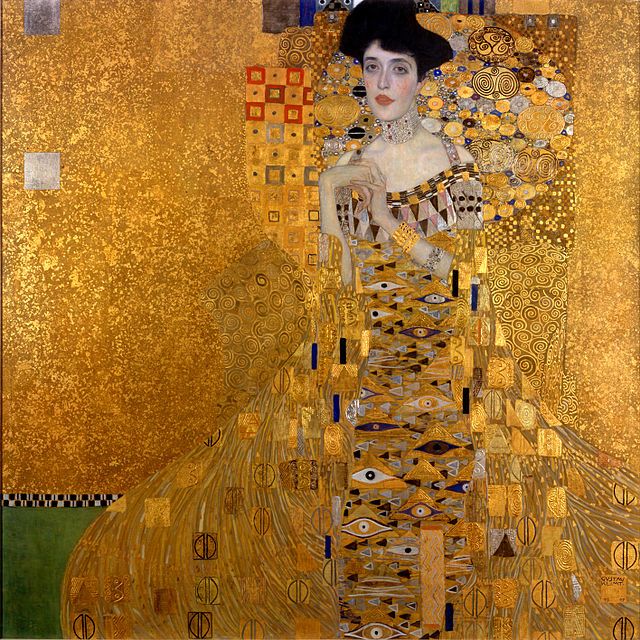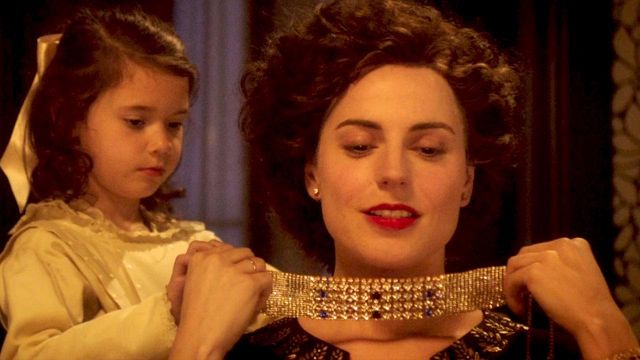David Walsh
Directed by Simon Curtis; written by Alexi Kaye Campbell
By the time of its downfall in 1945, the Hitler Nazi regime, its armed forces and police had looted hundreds of thousands of cultural objects from museums and individuals (it also destroyed thousands) in the territories, including Germany, under its control.
 Woman in Gold
Woman in Gold
Simon Curtis’s Woman in Gold is a fictional rendering of the legal efforts, beginning in 1998, undertaken by Maria Altmann, an Austrian Jew forced to flee the Nazis in 1938, to regain possession of several Gustav Klimt paintings stolen or coerced from her family. The remarkable story has been told in at least three documentaries, The Rape of Europa (2006), Stealing Klimt (2007) and Adele’s Wish (2008).
Living in modest circumstances in Los Angeles, Altmann (Helen Mirren) asks the son of a family friend, Randol Schoenberg (the grandson of composer Arnold Schoenberg, played by Ryan Reynolds), a lawyer who has had difficulties launching his legal career, to look into the case of the Klimt paintings. Her sister has just died and some letters from the late 1940s turn up, referring to an attempt to recover artwork once owned by the family.
 Woman in Gold
Woman in Gold
At the center of the dispute is one painting in particular, a portrait of Maria’s aunt, Adele Bloch-Bauer, done by Klimt (1862-1918), the famed symbolist and member of the Vienna Secession movement, in 1907. The picture hung at the time the film opens in the Belvedere gallery, an Austrian public museum, and the country’s establishment considers it an irreplaceable national treasure.
After hesitations on both their parts, Altmann and Schoenberg travel to Vienna to put their case before the committee charged with restitution of Nazi art. They encounter an ally there, Austrian journalist Hubertus Czernin (Daniel Brühl), whose research has uncovered important facts about the provenance of the Klimt paintings.
The Austrian government supports its claim to ownership of the paintings on the grounds that Adele Bloch-Bauer’s 1923 will (she died of meningitis in 1925 at the age of 34) expressed the wish that the works should go to the Austrian state museum. However, Schoenberg and Czernin learn that the paintings never actually belonged to Adele, and that her husband, Ferdinand, left them to his nieces (including Maria) and nephew when he died in 1945.
Nonetheless, the Austrian commission rejects Altmann’s claim. The cost of filing a lawsuit in Austria, calculated as a percentage of the worth of the pictures, would be prohibitive, more than $1 million. Defeated, Altmann and Schoenberg return to the US.
Interspersed with these scenes are flashbacks representing Maria’s memories of growing up in the 1920s and 1930s. Her affluent and sophisticated family inhabits the legendary world of early twentieth century Viennese culture and thought. Sigmund Freud and Arnold Schoenberg are family friends. As a child, Maria is entranced by her elegant aunt Adele (Antje Traue), painted twice by Klimt.
 Woman in Gold
Woman in Gold
In March 1938, only months after Maria (played as a young woman by Tatiana Maslany) has married Fritz (Max Irons), German troops mass on the Austrian border. Maria’s uncle Ferdinand (Henry Goodman), Adele’s widowed husband, prepares to leave for Zurich. Maria’s father (Allan Corduner) and mother (Nina Kunzendorf) are not so pessimistic. They remain, only to see Nazi officials strip them of their valuable belongings, including the Klimt paintings. Ultimately, Maria and her husband flee Vienna, leaving behind her parents, who both die at the hands of the Nazis.
Back in the present, Schoenberg convinces Maria they can take Austria to court in the US under provisions of a statute that sets out the ground rules for lawsuits against foreign governments. The case makes its way to the Supreme Court, where Schoenberg and Altmann prevail, encountering bitter opposition from the Austrian authorities at every point. Finally, the two parties agree to arbitration by a panel of three Austrians. Since the outcome is part of the historical record, we can report that Altmann wins back the paintings in 2006, some five years before her death in February 2011.
Curtis’s Woman in Gold treats a fascinating and complicated series of events, including some of the legal issues. Unhappily, the events and the personalities associated with them are considerably more fascinating than the work itself.
The strongest sequences are those set in the 1920s and 1930s in Vienna. The vignettes of family life are sensitively and thoughtfully done. One remembers the image of Maria’s father furiously playing his cello in a vain effort to drown out the growing roar of the fascist threat. The final scene between daughter and parents, whose tragic parting words are, “Remember us,” is extremely moving. Maslany, Corduner, Kunzendorf and Goodman are all effective and believable.
On the other hand, the contemporary scenes, which take up most of the film, are far less satisfactory. They seem duller and less substantive, organized and performed according to an unimaginative formula. One can almost set one’s watch by the predictable stages in the legal-political fight and the inevitable (and rapidly resolved) disputes between Altmann and Schoenberg, as well the tensions created at home, with wife Pam (Katie Holmes), by Schoenberg’s obsession with the case. Nor should Pam’s final “this is no time to quit, we’ve come so far” speech come as a surprise to anyone.
Mirren is enjoyable as the witty and irrepressible Maria, who remained lively and cogent until her death a few weeks before her 95th birthday. Reynolds, a talented performer, does not seem to know what to do with the rather colorless and quiet role he has been handed in Schoenberg. He flounders and never truly finds his way.
The American scenes are also rather conformist. There is no good reason why the filmmaker has to go out of his way to paint modern conditions in the US in such glowing and uncritical colors, including a warm and friendly tribute to that aging reactionary, Chief Justice William Rehnquist (Jonathan Pryce).
And one must say that even the Vienna sequences, thoughtful as they are, skim over the thorniest and most critical questions. One of those, incidentally, is the matter of Klimt’s art itself. While his portrait of Bloch-Bauer is extraordinarily striking, even mesmerizing, there are certainly issues bound up with the Secession movement, including its social indifference and Klimt’s allegiance to Nietzsche’s irrationalism, that deserve our attention today.
Moreover, there are the political and historical questions. Woman in Goldpresents the Austrian population, every man, woman and child in view, as wildly supportive of Hitler and fascism. But the political conditions existing in Austria in 1938 were largely shaped by the betrayals of the working class in the post-World War I era by the Social Democrats, who possessed a mass following. The Austrian workers showed their willingness to fight the class enemy throughout this period, especially in the general strike of 1927 and the quasi-civil war in 1934.
As Leon Trotsky noted in 1930, “Austrian Social Democracy helped the Entente to deal with the Hungarian revolution, helped its own bourgeoisie emerge from the post-war crisis, and created a democratic asylum for private property when it was staggering and close to collapse. Thus, through the entire post-war period, it has been the chief instrument for the domination of the bourgeoisie over the working class.”
That sections of the Austrian population welcomed the German troops and even tolerated the horrific crimes carried out against the Jews were signs of terrible political demoralization. As Trotsky noted, “In Austria, as everywhere else, fascism appears as the necessary supplement to Social Democracy, is nourished by it, and comes to power through its aid.”
In any event, the Austrian population in March 1938 was hardly universally behind Hitler. Mass opposition existed, forcing the Nazis to arrest some 70,000 Socialists and Communists and other opponents within days, and imprison or send them to concentration camps.
The absence in Curtis’s film of any consideration of the political and social contradictions extends, for that matter, to the treatment of Adele Bloch-Bauer herself. She may have been the somewhat ethereal, heavy-lidded creature Klimt painted in 1907, and whom Traue in Woman in Gold attempts to capture, but by the time she wrote her will in 1923, Bloch-Bauer was a changed woman, with definite social views, of a left-wing character.
Anne-Marie O’Connor, in The Lady in Gold: The Extraordinary Tale of Gustav Klimt’s Masterpiece, Portrait of Adele Bloch-Bauer, notes that in her will Bloch-Bauer left money to the Vienna Workers’ Association Friends of the Children, while her “immense library of books would go to the Peoples’ and Workers’ Library of Vienna.”
O’Connor writes, “Adele was immersed in the ideals of this ‘Red Vienna,’ and the battle for social justice.… The architects of this movement gathered at Adele’s house every week for a salon her family called her Red Saturday.” The author later adds, “At her Saturday salon, she spoke excitedly…about the creation of a new society in the Soviet Union.… She spoke of traveling…to witness the Soviet experiment.”
The history touched upon in Woman in Gold is laden with such rich and fraught complexities. It is a pity the film does as little as it does to present or convey them.
No comments:
Post a Comment